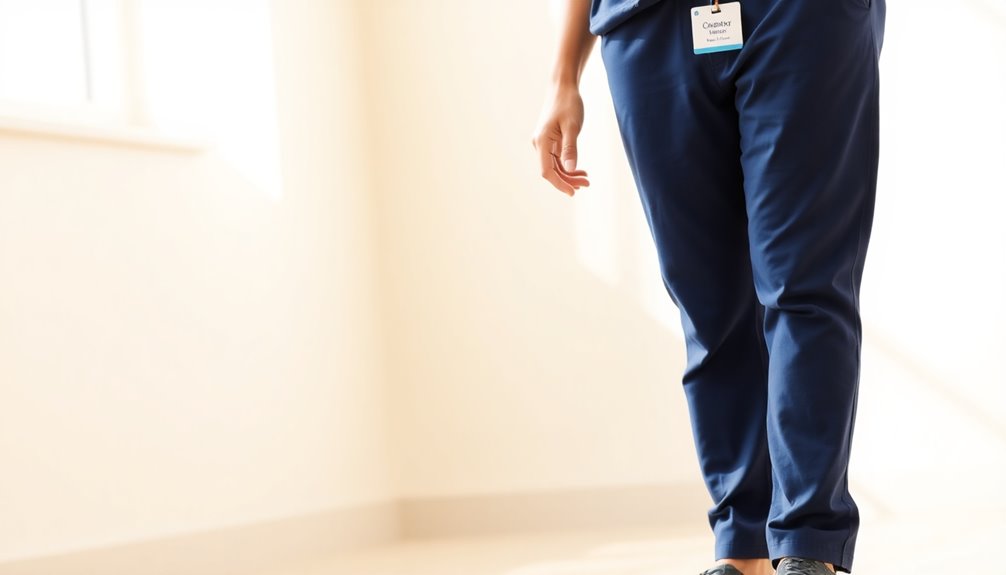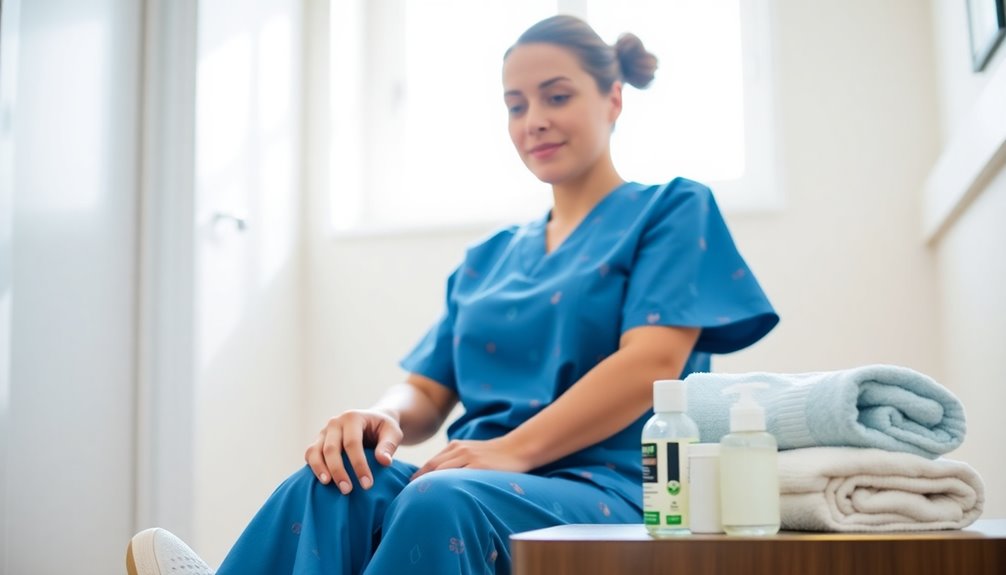Caregivers typically wear scrubs for their comfort, practicality, and hygiene in professional settings. However, you might also find them in company-branded polos and khakis, or casual clothing like jeans and nice tops, depending on the environment. Comfortable footwear is essential, as well as personal grooming to maintain professionalism. Each attire choice adapts to specific caregiving situations. If you're curious about how these factors play into caregiver roles, there's more to explore.
Key Takeaways
- Caregivers often wear scrubs for comfort, practicality, and to maintain a professional appearance in healthcare settings.
- In-home caregivers may opt for polo shirts and slacks to foster a relaxed and approachable atmosphere.
- Assisted living facilities typically require caregivers to wear scrubs to uphold cleanliness and enhance staff identification.
- Casual attire, like jeans and nice tops, is common for caregivers during outings to build rapport with clients.
- Personal grooming standards, including clean uniforms and trimmed nails, are essential for hygiene and professionalism in caregiving roles.
The Role of Scrubs in Caregiving

While scrubs may seem like just a uniform, they play an important role in caregiving. When you wear scrubs, you not only guarantee comfort and practicality for your daily responsibilities but also maintain a professional appearance that's essential in a healthcare environment.
Many agencies require you to wear scrubs, especially during initial shifts, to uphold cleanliness and professional standards. Scrubs help reduce the risk of cross-contamination, which is critical for residents with compromised immune systems.
Additionally, they allow easy identification of staff members, promoting a professional business image and enhancing safety in facilities. With customizable fabric, style, and color, scrubs enhance your comfort and functionality during long shifts, allowing for ease of movement as you care for others.
Alternatives to Scrubs: Caregiver Uniforms

Although scrubs are a common choice for caregivers, many agencies embrace alternatives like company-branded polos and khakis. These uniforms provide a professional yet approachable appearance, setting caregivers apart from traditional scrubs.
Some agencies even allow plain polo shirts with khaki or black pants, promoting comfort while ensuring a neat look for caregiving work. Uniforms often include company badges, enhancing identification and fostering trust with clients and their families.
Choosing a uniform is generally dictated by agency requirements, ensuring a consistent and recognizable image across the organization. This approach helps you maintain a professional demeanor, while also being flexible to accommodate personal preferences of clients during outings and social functions, making it an effective choice for professional care. Additionally, caregivers may find that a professional appearance can positively impact their interactions with clients, enhancing the overall caregiving experience.
Everyday Clothing Choices for Caregivers

When choosing everyday clothing, you'll want to prioritize comfort and practicality, especially during long shifts.
Seniors often appreciate casual attire like jeans and nice tops, as it helps build a closer relationship.
Don't forget to opt for comfortable footwear and maintain a professional appearance through good grooming.
Casual Attire Preferences
Casual attire plays an essential role in how caregivers connect with their clients, as many seniors appreciate a relaxed and approachable look during outings and social events.
Choosing personal everyday clothing can foster closer relationships, making the caregiving experience feel more comfortable and familiar.
Agency Director Shelley Ballinger-Adkins notes that clients often prefer caregivers dressed casually, enhancing their comfort level.
While wearing casual attire, you should guarantee your clothing is clean and trimmed to maintain hygiene standards.
This balance allows you to prioritize comfort and functionality, enabling you to move easily while assisting clients in daily activities.
Ultimately, your choice of casual clothing can make a significant difference in the bond you share with those you care for.
Practicality and Comfort
Choosing everyday clothing that prioritizes practicality and comfort is vital for caregivers as they navigate their daily responsibilities.
You'll want breathable fabrics like cotton or moisture-wicking materials that keep you comfortable during long shifts. Opt for clothing with practical features, such as pockets for carrying essential items.
It's also important to select garments that are easy to clean and resistant to stains, given the nature of caregiving tasks. Close-toed shoes are a must for providing foot protection and stability while assisting clients.
Casual attire often works best, creating a familiar and approachable vibe for clients during outings or social functions.
Relationship Building Through Clothing
Everyday clothing choices play a significant role in relationship building for caregivers. When you wear casual attire like jeans and nice tops, it fosters a sense of comfort and familiarity, enhancing your connection with clients.
Seniors often prefer this relaxed style for outings, creating a welcoming atmosphere. Being flexible in your clothing allows you to gauge family preferences, improving trust and rapport. This adaptability not only enhances comfort during their experiences but also fosters deeper connections among family members. When planning outings, consider incorporating travel tips for senior travelers, which can help address their specific needs and preferences. By doing so, you empower them to enjoy their adventures fully, ensuring both safety and enjoyment throughout the journey.
Your personal clothing choices can reflect your personality, making you more approachable and relatable. This authenticity strengthens emotional connections with those you assist.
Ultimately, when you prioritize comfort and style in personal care settings, you not only meet practical needs but also nurture meaningful relationships that contribute to a positive caregiving experience. Additionally, mindful decluttering of your wardrobe can help you maintain a polished appearance while ensuring your clothing choices remain practical and functional.
Key Considerations for Caregiver Attire

When considering caregiver attire, it's important to balance practicality with professionalism. Most caregivers wear scrubs or uniforms that align with their agency's dress code, which can vary greatly.
Comfort and ease of movement are imperative, so opt for breathable, easy-to-clean fabrics. Wearing scrubs not only enhances your professional appearance but also helps clients identify you in healthcare settings.
Don't forget about personal grooming; clean, trimmed nails are essential for maintaining hygiene. Additionally, consider your clients' preferences—many seniors appreciate casual clothing that fosters a personal connection.
Ultimately, choosing the right attire involves understanding both your workplace requirements and the needs of those you care for, ensuring a positive and professional environment. Additionally, being aware of cookie usage can help protect both your privacy and the privacy of those you care for in a digital world.
Importance of Accessories and Hygiene

When caring for others, your accessories and hygiene play an essential role in ensuring safety and comfort.
Keeping your nails trimmed and clean prevents accidental scratches, while avoiding dangling jewelry minimizes accident risks.
Also, maintaining personal hygiene protects both you and your clients from germs and illnesses.
Nail Hygiene Standards
Maintaining proper nail hygiene is essential for caregivers, as it not only safeguards clients from potential harm but also reinforces a professional appearance. Clean, trimmed nails help prevent scratches and reduce the risk of bacterial transmission. Avoid long or artificial nails, since they can harbor germs and complicate personal hygiene tasks. Regularly washing your hands and keeping your nails short is crucial for minimizing the spread of germs, creating a hygienic environment for both you and your clients. Additionally, adhering to nail hygiene standards boosts your personal grooming and builds trust with clients and their families. Incorporating practices such as using anti-inflammatory herbs can further enhance overall wellness and hygiene.
Jewelry Safety Considerations
Nail hygiene is just one aspect of presenting a professional image as a caregiver.
When it comes to accessories, you should prioritize safety and practicality. Avoid wearing dangling jewelry, as it can lead to accidents or entanglements while you assist clients. Minimal and practical accessories are ideal, ensuring they don't hinder your movements during caregiving tasks.
Additionally, strong perfumes and heavily scented products are typically discouraged to prevent discomfort or allergic reactions in sensitive seniors. Maintaining good hygiene and grooming is essential, not just for aesthetics, but also for preventing the spread of germs. Furthermore, adhering to proper maintenance practices can enhance overall safety and hygiene in caregiving environments.
Personal Hygiene Practices
While personal hygiene practices are essential for all professionals, they take on heightened importance for caregivers who work closely with clients.
Keeping your nails trimmed and clean is vital to prevent scratching and guarantee safety. Avoid wearing dangling jewelry to minimize accidents while assisting clients, and steer clear of strong perfumes, as many seniors may be sensitive to scents.
Upholding personal hygiene helps prevent the spread of germs and maintains a professional image.
Additionally, consider using easy-to-clean bags with pockets to organize your personal items. This way, you can keep everything clean and accessible, further promoting hygiene and efficiency in your caregiving role.
Comfort and Functionality in Caregiver Clothing

When it comes to caregiver clothing, comfort and functionality are essential for performing demanding tasks effectively.
You'll find that many professional caregivers opt for scrubs made from breathable, soft fabrics like cotton, which provide all-day comfort during long shifts.
The design of these clothes focuses on ease of movement, allowing you to bend, lift, and assist clients without restriction.
Customizable options in fabric, style, and color enhance your satisfaction while maintaining a professional appearance.
Practical features like pockets and elastic waistbands make it easy to carry essential items while ensuring comfort.
Additionally, easy-to-clean fabrics help you stay hygienic and presentable, making them a pivotal choice in caregiving environments.
Dressing for Various Caregiving Environments

As you navigate different caregiving environments, choosing the right attire is essential for both comfort and professionalism. Each setting has unique dress codes that reflect the atmosphere and needs of your clients. Additionally, maintaining a professional appearance can help establish trust, which is crucial for fostering good oral hygiene habits in children.
| Caregiving Environment | Recommended Attire | Purpose |
|---|---|---|
| In-home Care | Polo shirts and slacks | Maintain comfort |
| Assisted Living | Scrubs | Cleanliness and identification |
| Hospice Care | Subdued colors and comfortable fabrics | Create a calming atmosphere |
| Social Outings | Everyday clothing | Foster personal connections |
| Nursing Homes | Facility-specific uniforms | Respect client dignity |
Personal Grooming Standards for Caregivers

Personal grooming standards are important for caregivers, not only to present a professional image but also to foster trust with clients and their families.
You need to guarantee your uniforms or scrubs are clean and well-maintained. A tidy appearance, including clean and trimmed fingernails, is essential to prevent any accidental scratching of clients.
Wearing a name tag prominently enhances identification and conveys professionalism in your role. Additionally, attention to personal hygiene is critical to prevent the spread of germs, especially for clients with compromised immune systems.
Ultimately, your grooming and appearance reflect your commitment to care, contributing to a positive caregiving experience. Aim for a polished look, as it reassures clients and their families about your dedication.
Adapting Attire to Seasonal Changes

Adapting your attire to seasonal changes is essential for maintaining comfort and professionalism as a caregiver.
In colder months, layer your clothing by wearing long-sleeve tops under your scrubs to stay warm while ensuring ease of movement.
For warmer seasons, choose breathable fabrics like cotton or moisture-wicking materials to keep cool during long shifts.
You can also brighten up your look with seasonal patterns and colors in your scrubs, making you feel festive and relatable to your clients.
Don't forget about footwear; opt for waterproof or insulated shoes in winter and lightweight options in summer.
Accessories like lightweight cardigans or jackets provide extra comfort without sacrificing your professional appearance in home care settings.
Frequently Asked Questions
Do You Wear Scrubs as a Caregiver?
Do you wear scrubs as a caregiver? It really depends on your agency's policies and the environment you work in.
Many caregivers find scrubs practical due to their comfort and easy maintenance, especially in healthcare settings.
However, you might also choose to wear everyday clothing or uniforms based on client preferences or specific job requirements.
Ultimately, your attire should support your work while keeping you comfortable and professional in your caregiving role.
What Is the Dress Code for a Home Health Aide?
When you're a home health aide, the dress code varies by agency and client preferences. You might wear scrubs for professionalism, or casual attire like khakis and polos for comfort.
You'll follow specific guidelines about cleanliness, personal grooming, and maintaining a neat appearance. Prioritizing comfort and functionality is essential, as you need clothing that allows for easy movement while assisting clients.
Flexibility in your attire will help you meet both agency and client expectations.
What Is the Dress Code for a Carer?
When you consider the dress code for a carer, it really depends on the agency you work for and the setting.
Some might require you to wear scrubs, especially in healthcare facilities, while others allow more casual attire like polos and khakis.
In home care, you often get to choose personal clothing, helping you connect better with clients.
Always be ready to adapt based on client preferences and specific situations.
What Do Caregivers Really Need?
As a caregiver, you really need to focus on a few essentials.
First, prioritize comfortable clothing that allows you to move easily while performing tasks. You'll also want proper footwear to support you during long shifts.
Staying organized with supplies, like first aid kits or personal items, is essential.
Finally, maintaining good hygiene and a tidy appearance builds trust with clients, ensuring you create a positive environment for everyone involved.
Conclusion
So, what do caregivers really wear? Whether it's those iconic scrubs or more casual attire, it all boils down to comfort, functionality, and professionalism. As you navigate different caregiving environments, you'll find that every piece of clothing you choose tells a story about your role. But wait—what if that simple choice could impact not just your day, but the lives of those you care for? The answer might just surprise you. Keep exploring!








